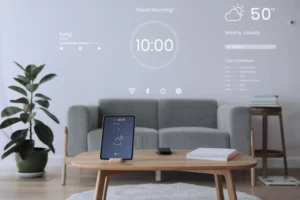With more than a 1 billion number of new smartphones are Purchased and 179 billion number of mobile applications are downloaded per year, mobile development is one of the innovative and actively growing sectors in the Tech Market. In mobile application market Google applications (Gmail, Maps, and Search), social networks (Facebook, Instagram, Twitter, YouTube) and gaming applications have Dominated. Finally, a successful mobile strategy involves more than a mobile-friendly website. Mobile application development is fueled by technological advancements, necessitating a long-term plan for businesses. The following are some of the trends that will shape the future of mobile app development.

- DEVICES THAT CAN BE USED
Smart devices such as Apple Watch and Hololens show an extreme shift in computing and communication. This opens new opportunities for vendors, Mobile application developers, and also for accessory manufacturers. Body health care sensors, innovative jewelry, smart watches, display gadgets (like Google Glass), and a variety of sensors embedded in clothing and footwear will all connect to the smartphone as the hub of a personal area network. All These devices will communicate with mobile applications to deliver information in different ways with Modern Technology. And it will enable a wide range of products and services in areas such as sports, fitness, fashion, hobbies and health. Therefore, devices connected with smartphones will help in influencing the next generation of mobile application development strategies. Are you looking for a mobile app developer in Dubai?

- INTERNET OF THINGS AND SMART OBJECTS CONNECTED TO MOBILE PHONES
Innovative home devices will be connected to the Internet of Things and communicate with one another via a smartphone or tablet app. Smartphones and tablets will serve as remote controls, showing and analyzing data, engaging with social media to keep track of “things” they can tweet or post, paying for subscription services, purchasing replacement consumables, and updating the object’s firmware. Internet of Things features is being added to the portfolios of established companies like Microsoft’s Intelligent Systems Service and enterprise software providers like SAP’s Internet of Things Solutions.
RiotOS and Thingsquare Mist are currently known as the top software technologies, whereas RFID, Wi-Fi, EnOcean, and many other communication technologies are used for IoT. Nest and Brillo are two Google projects that are focused on IoT. In addition, Apple recently launched some “Homekit” products that allow you to have wireless and electronic control of your home appliances. Products include dimmers, air monitors, a thermostat, and a complete smart home hub that can be controlled via apps and Siri, allowing homes to be automated using voice commands. Along similar lines, Amazon launched the “Amazon Echo,” a voice command device for answering any type of questions, playing music, and controlling other smart devices. A complete list of technologies that power IoT can be found in the Postscapes labs.

- M-COMMERCE
As more consumers adopt mobile commerce, several analysts anticipate that the favourable trend in mobile purchasing will continue for the next four years. This will require developers to create a mobile app development Dubai that can process transactions without physical debit/credit cards or cash. Along with many portable devices that can process payments, mobile commerce will take a different form. Beyond data collection and predictive analytics, wearable devices will also play a vital role in the future of mobile payments and customer loyalty.
![]()
- MOVEMENT AND LOCATION DETECTION
Most mobile phones contain location sensors that can offer different granularities of location data using numerous positioning algorithms. Knowing a person’s exact position within a few metres can help provide highly relevant contextual information and services. Motion detection applications are used in security, anti-theft, power-saving, and gaming. Location detection is helpful in geotagging, gaming, vehicle navigation, and fitness applications. Applications that take advantage of precise indoor location currently use technologies such as Wi-Fi, imaging, ultrasonic and geomagnetic beacons. In the long term, technologies like bright lighting will also be necessary. Accurate indoor location sensing, combined with mobile apps, will enable a new generation of highly personalized information and services.

- INNOVATIVE DESIGN OF MOBILE USER EXPERIENCE
Adequate visualization of data and content in your mobile user interface is essential for a robust user experience. Successful mobile app companies, such as Houzz, Instagram, Pinterest, and Wunderlist, have developed new patterns representing intuitive layouts and interactive interfaces. Designers are also creating applications that can adapt to mobile challenges such as partial user attention and interruption. Applications must utilise technologies with novel features such as interactive content layers, circular design patterns, cards, and content manipulation. By allowing users to engage with content in more detail, these elements produce “augmented reality.” Leading consumer applications are setting new standards for user interface design, and all businesses must learn new skills and collaborate with new partners to keep up with rising customer demands.

- MANAGEMENT OF APPLICATION PERFORMANCE (APM)
Performance bottlenecks in a application testing are caused by two factors only: the diversity of mobile devices and the non-deterministic nature of mobile networks. Application Performance Management (APM), a collection of mobile metrics and monitoring tools, has improved testing and quality assurance. APM provides visibility to the application behavior, statistics on which devices and operating systems are adopted, and monitors user behavior to determine which application functions are successfully exploited. However, with the enterprise infrastructure and application landscape shifting to the cloud, APM tools face more significant challenges to deliver real performance benefits across systems with virtual perimeters. Modern days businesses require good tools that can be use to monitor the resources used by applications, correlate that data with meaningful user information, and align performance with business processes.
We can’t deny that mobile apps have become a necessary part of the digital environment. The talents required to develop consumer applications are in higher demand than ever before, driving businesses to priorities mobility. To coordinate their mobile app development plans, companies must be aware of these developments. As a result, there is a rise in the number of mobile app development companies to meet the increasing demands.
To get your idea to life, contact the top mobile app development company in Dubai.